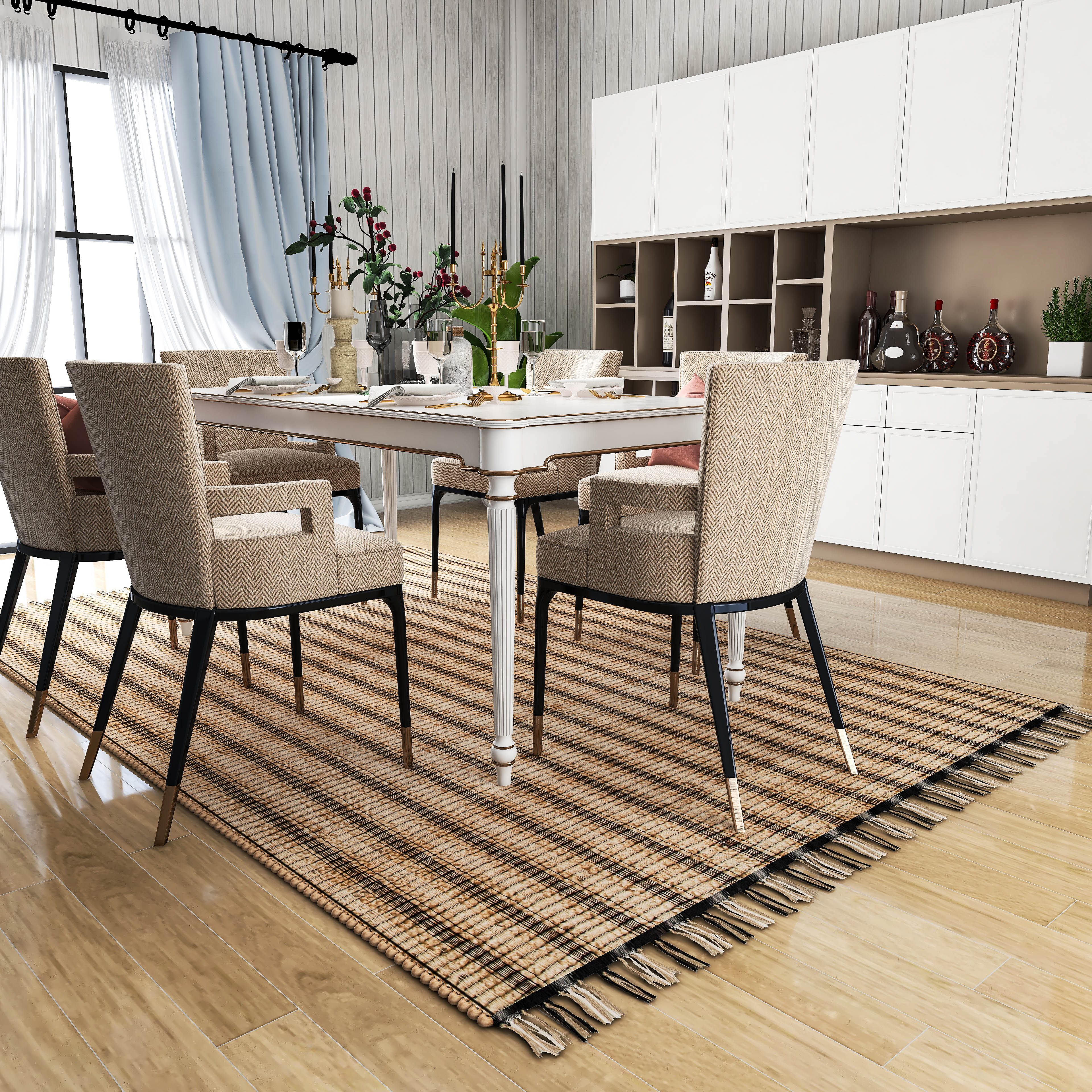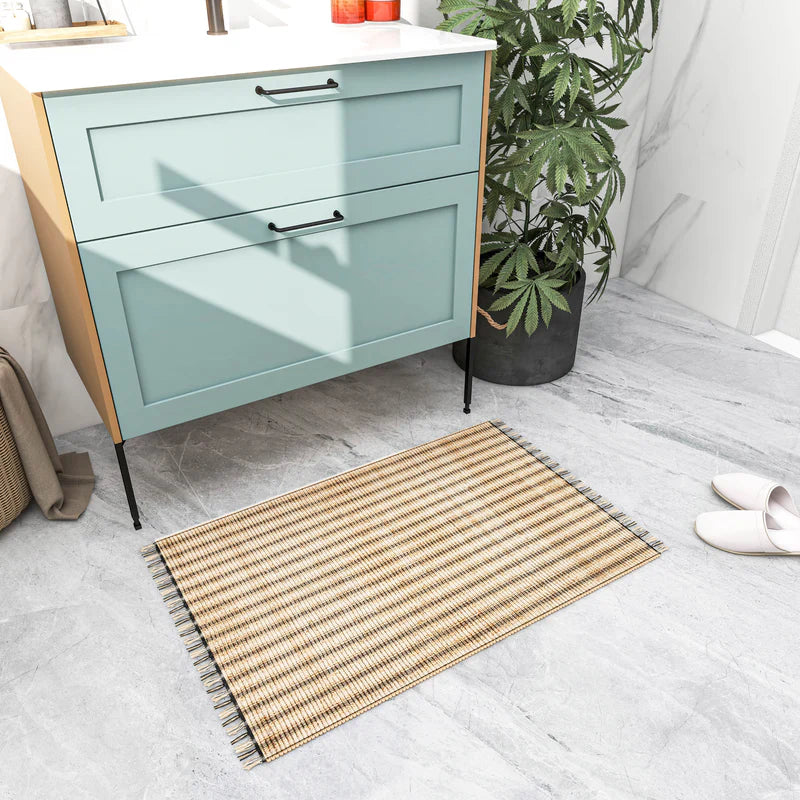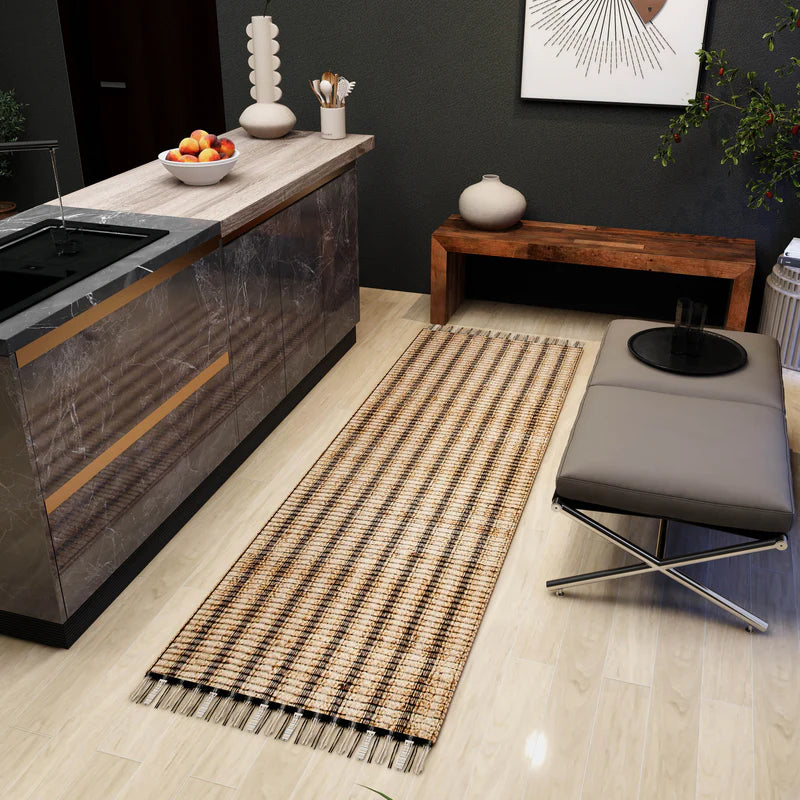Article: How to Clean a Woven Rug: Complete Care Guide for Long-Lasting Beauty

How to Clean a Woven Rug: Complete Care Guide for Long-Lasting Beauty
Key Takeaways:
- Know Your Rug: Different materials need specific care—choose gentle, pH-neutral cleaners.
- Routine Cleaning: Regular vacuuming and immediate spill blotting keep fibers fresh.
- Prevent Wear: Rotate rugs and use pads to extend their life.
- Professional Help: For deep cleaning, call in experts.
- Store Properly: Clean, dry, and roll in breathable fabric to avoid damage during off-seasons.
Ever spilled red wine on a cherished oriental rug or found hard-to-remove hair tangled in the carpet fibers? Relief is in sight. This comprehensive guide zeroes in on the pivotal steps needed to maintain your woven rugs, ensuring their enduring beauty.
You'll discover how to choose the right cleaning products, protect the delicate weaves from daily wear, and tackle stains with confidence.
By engaging with this content, you'll transform your approach to rug care, visibly extending the life and allure of your carpets while avoiding potential pitfalls like stubborn stains and damage from improper cleaning techniques.
Understand Your Woven Rug's Material and Weave

Delving into the world of woven rugs requires a keen eye for their intricate weavings and the unique materials they're made from. Recognizing the difference between a sisal mat and a richly patterned tapestry involves understanding the foundations of rug weaving.
By identifying the type of weave and material, one can better apply the proper cleaning techniques, whether involving a gentle vacuum or the right laundry detergent safe for use in a machine. Each rug demands a specific approach to care and maintenance for its beauty to endure.
The forthcoming segments will expertly guide readers through identifying and differentiating types of woven rugs, along with a thorough exploration of common materials used in their creation.
Identify and Differentiate Types of Woven Rugs
Recognizing the different types of woven rugs is key to their care; each has unique vulnerabilities such as mildew with natural fibers, or the dreadful paint spill over a hand-knotted silk masterpiece.
One might find that a broom can be a better choice than a vacuum for a delicate antique rug to prevent damage, whereas a machine-washable cotton rug can endure a more rigorous cleaning method.
When dealing with accidents like nail polish spills, the material of the rug becomes critical. Silk rugs, prized for their delicacy and shine, require immediate attention with a specialized cleaning solution, while more durable materials such as wool might allow for slightly delayed maintenance.
The owner’s knack for identifying the rug’s weave and fabric can turn a potential catastrophe into a manageable cleanup.
Recognize Common Materials Used in Woven Rugs
In the realm of interior design, the proper recognition of woven rug materials is paramount for their upkeep.
The resilience of wool woven rugs to common stains is well-known, making them a favorite among homeowners. Wool can usually withstand cleaning with mild detergents, but abrasive chemicals like bleach must be strictly avoided to preserve the fibers' natural oils and colors.
For everyday upkeep, a high-quality vacuum cleaner equipped with adjustable suction is recommended to prevent the fraying of these durable pieces.
Conversely, rugs crafted from natural plant fibers such as jute or sisal offer an earthy aesthetic but demand a different care approach. These materials can be sensitive to water, so instead of traditional shampoo cleaning methods, a dry cleaning powder approved for use with natural fibers is often advised.
Spot cleaning with a gentle mixture of vinegar and water can be effective for light stains, ensuring the beauty of these woven rugs remains intact without over-saturating the fibers, which could lead to irreversible damage.
Establish a Regular Cleaning Routine for Woven Rugs
A regular cleaning routine is crucial in preserving the beauty and longevity of woven rugs, keeping issues like mold and dust at bay. Vacuuming correctly ensures the removal of dust that settles deep within the fibers, while prompt spot cleaning of spills can prevent stubborn stains, safeguarding the delicate weave.
Whether crafted from polyester or other materials, a methodical approach using tools such as a squeegee can mitigate the effects of everyday wear and maintain your rug's pristine condition. Stay tuned as we delve deeper into effective ways to vacuum and spot clean your cherished woven rug.
Vacuum Your Woven Rug Properly to Remove Dust
Before initiating the vacuum process, one should always conduct a spot test in an inconspicuous area to safeguard against any unexpected color or fiber reaction.
A gentle, weekly vacuuming can vastly enhance a woven rug's appearance, preventing the accumulation of soil that dulls its intricate design. This routine maintenance keeps the room fresh and extends the rug's life by preempting deeper soil embedment over time.
It's prudent for one to use a vacuum with adjustable settings when caring for these decorative pieces. A lower suction is ideal as it refreshes the rug without agitating the fibers too vigorously, thus reducing potential damage.
Focusing on high traffic areas, one should meticulously pass the vacuum in overlapping strokes to ensure that every inch of the rug is treated, effectively lifting the dust and maintaining the rug's vibrant allure.
Spot Clean Spills Immediately to Prevent Stains
When a spill occurs on a woven rug, especially one with delicate dyes or materials such as sheepskin, prompt action is imperative. Blotting—not rubbing—the affected area immediately with a clean, absorbent cloth helps prevent the liquid from seeping deeper into the fibers.
For those more persistent spots, employing a bit of dry cleaning solution can be effective, so long as it is appropriate for use with the rug's specific material.
In preventing the adhesion of dirt and contaminants that can tarnish a rug's appearance, one must understand the essence of rug care. Rugs that feature intricate weavings or plush pillows necessitate an attentive eye for immediate spot cleaning, thereby safeguarding the rug's dye integrity and aesthetic charm.
A swift, but gentle, cleaning approach is essential to maintain the rug's exquisite beauty without causing damage to its structure or color vibrancy.
Use Appropriate Cleaning Products and Methods

Selecting the right cleaning products is crucial for the care of woven rugs, ensuring their lasting beauty without causing harm. A mild dishwashing liquid, when used appropriately, can effectively clean without damaging delicate fur or vibrant dyes.
Heat and harsh chemicals pose a risk to the natural fibers, necessitating alternatives such as gentle blotting with a paper towel and rinsing with a hose when appropriate. The upcoming discussion will focus on choosing safe solutions and avoiding damaging cleaning practices for optimal rug maintenance.
Choose Safe Cleaning Solutions for Woven Rugs
Choosing cleaning solutions for rugs made from sensitive materials such as jute requires careful consideration. Harsh chemicals can strip these natural fibers of their resilience and vivid color. Owners should opt for gentle, pH-balanced cleaners that can disinfect without the risk of damage.
In case of stains on your woven rug, whether it's a traditional dhurrie or a modern synthetic fiber mat, always conduct a patch test with your chosen solution to ensure color integrity and material safety before proceeding with a full clean.
For homeowners who prefer eco-friendly options, a mixture of water and white vinegar can act as an effective disinfectant for tackling mild stains on woven rugs.
This natural alternative is ideal for a quick refresh that maintains the color and texture of a dhurrie or synthetic fiber rug. While commercial products are available, those specifically designed for rug care will often yield the best results, preserving your rug’s beauty through countless footfalls and life’s little mishaps.
Avoid Harsh Chemicals That Damage Fibers
Rug enthusiasts should be wary of robust chemicals like bleach, which can brutally compromise the integrity of delicate rug fibers. An alternative, hydrogen peroxide, may seem benign but it requires cautious application; improper use can lead to moisture retention that weakens textile strength over time.
Instead, owners should seek out gentle mixtures specifically formulated for rug care, ensuring that the aesthetic and structure of their intricate weavings remain unaffected.
It's not common wisdom, but a snow bath can act as a gentle and effective cleaning method for rugs, bringing a surprising benefit when other techniques pose a risk.
This approach, leveraging the natural cleansing properties of fresh snow, avoids harsh chemicals entirely, allowing the rug's fibers to maintain their vigor and lush texture. Utilizing non-invasive methods like this preserves the woven rug's beauty without the harsh consequences of aggressive treatments.
Protect Your Woven Rug From Wear and Tear
To preserve the elegance and longevity of your woven rug, implementing measures against wear is essential. The subsequent advice will focus on the importance of routinely rotating your rug to distribute wear evenly and utilizing rug pads as a foundation to prevent slippage, thus ensuring your rug's lifespan.
These methods not only aid in maintaining the rug's condition but also enhance the suction of your vacuum cleaner, effectively removing debris without damaging delicate wood floors or upholstery.
Rotate Your Rug Regularly to Even Out Wear
Rotating your rug ensures even wear, mitigating the risk of premature aging and maintaining a balanced look on the floor. This practice is especially vital in high-traffic areas where footfall can quickly lead to visible wear patterns.
By shifting the position of a rug every few months, one aids more uniform exposure to sunlight and foot traffic, thus offering all parts of the kilim or microfiber rug equal time under the strain of daily use.
Additionally, consistent rug rotation prevents certain areas from becoming too worn or faded, especially where accidental spills, such as wine, might occur more frequently.
Not only does this rotation help preserve the rug's structural integrity, but it also facilitates more effective cleaning, whether it's a simple vacuuming routine or a visit to the washing machine for machine-washable types. Homeowners will find that this simple step extends the life and appearance of their woven treasures.
Use Rug Pads to Prevent Slippage and Extend Life
Introducing a high-quality rug pad beneath your woven rug not only mitigates the risk of dangerous slippage but also acts as a shield against the grinding abrasion of everyday foot traffic.
Such a pad functions almost like a cushion, distributing the stress applied to the rug's fibers from footsteps or the uneasy drag of furniture, thereby prolonging the rug's life and beauty. It's an indispensable tool for any homeowner looking to maintain the pristine condition of their beloved cotton, wool, or synthetic area grounds.
Rug pads also have the hidden advantage of making cleaning routines more efficient. They provide a stable base that enhances the effectiveness of a vacuum cleaner, allowing for the removal of entrenched dirt like tracked-in mud without straining the weave of the rug.
Additionally, in the event of liquid spills, the pad can help prevent a cleaning agent or water from soaking through to the floor—a bottle of spilled wine becomes a non-issue when your rug is well protected.
Address Deep Cleaning and Professional Care

While DIY solutions work for routine upkeep, heavier soiling and intricate fibers like wool may necessitate professional rug cleaning. Recognizing when expert intervention is required is critical for preserving your rug's integrity and combating persistent odors.
Preparing your rug for such services is equally important. These sections will outline the indicators for professional cleaning and the steps to prepare your woven rug, ensuring it receives optimal care without damaging its delicate fibers.
Know When to Seek Professional Rug Cleaning
There comes a time when your cherished woven mat transcends what regular laundry care can restore—perhaps due to pet accidents or deeply ingrained dirt from heavy furniture. This is when the expertise of professional rug cleaning becomes indispensable.
These specialists employ advanced methods, such as using a carpet beater to gently expel dust without damaging fibers, ensuring every thread of your precious rug is treated with the utmost care.
While frequent vacuuming and spot-cleaning are key, the resilience of your rug may diminish with relentless foot traffic or after a big spill has set in past the surface.
Professional cleaners have the capacity to deep clean without compromising the intricate weave of your carpet, employing technology and solutions beyond the scope of home care.
When your once vibrant rug begins to look dull and the air feels less fresh, trust in a professional service to rejuvenate its beauty and extend its life within your home.
Prepare Your Rug for Professional Services
Before inviting professional rug cleaners into your home, initiate the preparatory steps by tending to the more glaring issues.
If accidental urine stains lie beneath your couch, blot these using a sponge and a mixture of water and mild detergent in a spray bottle, potentially sparing the professional team some labor and ensuring a more thorough rejuvenation of your prized floor covering.
An important preparatory measure is to free the rug of loose dirt or debris by giving it a thorough vacuuming. The goal here is to eliminate surface particles that could otherwise impede the deep cleaning process.
By diligently removing these top-layer contaminants, you set the stage for the professionals to target the ingrained dirt and allergens, maximizing the effectiveness of their specialized equipment and expertise.
Store and Maintain Your Rug During Off-Season

As we venture into the quieter months, the longevity of your woven rug hinges on proper storage practices. Preparing your rug for periods of disuse demands a comprehensive approach that includes pre-storage cleaning with a mild detergent, careful brushing to alleviate any embedded dirt, and secure wrapping to guard against the challenges of carpet cleaning when unrolled.
Ensuring your rug remains moth-free and dry, even when tucked away in storage, can be as crucial as regular cleaning routines. The following sections guide you through proven techniques to prepare and shield your rug from common storage afflictions such as moth damage and moisture, maintaining its splendor for the seasons to come.
Prepare Your Woven Rug for Storage Properly
Properly storing your woven rug at the end of the season is paramount for preserving its natural fibers and avoiding pressure-induced deformities. A thorough cleaning is advisable; use a garden hose with a gentle spray setting to remove any residual dirt from polypropylene rugs without saturating the material.
Allow the rug to dry completely in a well-ventilated area before storage to prevent mold, ensuring a foam underlay is placed beneath if needed to cushion it from the hard ground.
To maintain the integrity of your woven rug during storage, roll it rather than folding to avoid creating pressure points that can damage its structure.
Encase the rug in a breathable fabric, not plastic, which can trap moisture and lead to damage. If your rug features natural fibers, consider wrapping it with a protective material that shields it against pests without the use of harsh chemicals that could degrade the fibers over time.
Prevent Moth Damage and Moisture During Storage
To prevent moth damage to your woven shag rug while in storage, ensure that the cleaning process includes a gentle soap specifically designed for rug care.
After a complete dry, seal the rug in a breathable cotton wrap; this simple step keeps moths at bay and retains the rug's luxuriant texture without resorting to harsh chemical repellents that may harm its delicate fibers.
In the fight against moisture, it's advisable to store your rug off the floor on a raised platform in a dry, well-ventilated space. To safeguard against any potential moisture accumulation, slip a few sheets of absorbent paper towels within the roll before wrapping.
This acts as an insurance policy, wicking away any condensation that might sneak in over the cooler months, ensuring your rug looks as splendid coming out of storage as it did going in.
Understanding the material and weave of your rug is essential for applying suitable care methods that ensure its lasting beauty. Regular maintenance, including vacuuming, spot cleaning, and using the correct cleaning products, protects the rug from daily wear and extends its life.
Professional cleaning services and proper storage techniques preserve the rug's integrity, ensuring it remains a vital part of your home's aesthetic for years to come. In essence, the vitality of your woven rug's appearance and durability is deeply rooted in the knowledge and dedication you invest in its care.
FAQs
How to clean a dirty woven rug?
To clean a dirty woven rug, vacuum both sides thoroughly to remove surface dirt. For stains, use a gentle cleaner or mild soap solution. Spot clean with a soft cloth, avoiding excessive moisture to protect the fibers.
How to clean a woven rug by hand?
Vacuum the rug first to remove loose debris, then use a mixture of water and mild soap. Gently scrub with a soft brush, working in small sections, and rinse with a damp cloth. Allow the rug to air dry completely.
How do you deep clean a flat woven rug?
Vacuum both sides to remove dust, then use a mild soap solution and a soft brush to scrub gently. Rinse lightly with a damp cloth, ensuring no soap residue remains. Let it dry flat in a well-ventilated area.
What is the best way to clean a braided rug?
Shake out loose dirt, then vacuum both sides. For spot cleaning, use a mixture of mild soap and water, scrubbing gently along the braid lines. Rinse carefully with a damp cloth and allow the rug to air dry flat.








